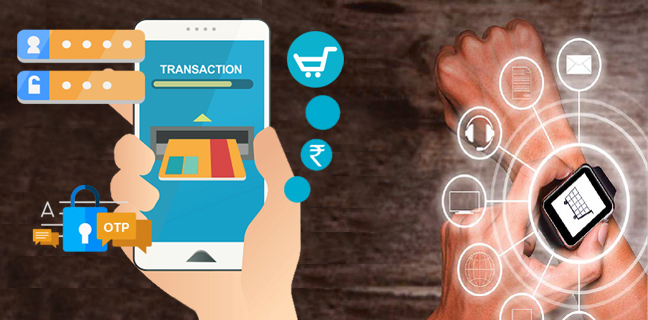India is aspiring to transform itself into a fully digitised economy. To realise this dream, the Central Government with the cooperation of several organisations and individuals has brought in revolutionary changes in the recent past, Digital India is one such flagship programme. Despite the rising usage of digital payments, the security still remains a concern. Rashi Aditi Ghosh of Elets News Network (ENN) explores the safety quotient with regard to the increasing popularity of e-payments in India.
Government Initiatives for Boosting e-payments
 The Government has incentivised the usage of BHIM App for making digital transactions. With effect from January 2018 Merchant Discount Rate (MDR) on debit card transactions of value upto Rs 2000 is to be reimbursed to the banks by the Government in order to bring such transactions on par with cash.
The Government has incentivised the usage of BHIM App for making digital transactions. With effect from January 2018 Merchant Discount Rate (MDR) on debit card transactions of value upto Rs 2000 is to be reimbursed to the banks by the Government in order to bring such transactions on par with cash.
Several ministries and departments such as Railways, Petroleum and Natural gas etc are offering incentives to promote digital payments. Through the programme of Pradhan Mantri Gramin Digital Saksharta Abhiyaan (PMGDISHA) measures are afoot to train six crore persons in rural areas, across.
“Most financial institutions believe that the younger, newer customers prefer digital banking over traditional banking. Digital banking also allows a bank to acquire new customers in newer territories quickly. The cost of managing these customers is also far lower,” said Abhishek Pandit, Director – Business Services, AISECT.
States/UTs in various aspects of digital literacy including digital financial literacy, covering one member from every eligible household in about 40 per cent of rural households by March, 2019. There are 2,92,406 number of Community Service Centres (CSCs) of which 1,83,005 number are operating in rural area and these CSCs play crucial role in enabling and facilitating digital transactions.
Witnessing a growth of 4.73 per cent, the digital payments in India reached a record high of 1.11 billion in January 2018. As per the Reserve Bank of India (RBI), the digital transaction value collectively inflated to $2 trillion in January.
- In 2017-18, 20.3 billion digital transactions were reported in India.
- The volume of transactions in e-payments grew by five times in the last four years, according to data by Ministry of Electronics and Information Technology. While the volume of transactions was reported at 317.60 crore in Financial Year 2014-2015, it inflated to 1605.30 crore in Financial Year 2017-2018.
- Not just volume but the value of transactions in terms of e-payments also grew in 2017- 2018 as compared to 2014-2015. It reported a growth of 1.5 times.
- Centre’s flagship initiative Unified Payments Interface (UPI)-Bharat Interface for Money (BHIM) and USSD (Unstructured Supplementary Service Data) collectively achieved 7.6 times growth during November, 2016-February, 2018.
- Data suggests that that Immediate Payment System (IMPS) grew by 240 per cent during the above mentioned period.
“India is a cash-based economy with transactions from small disorganised merchants to organised retail being predominantly in cash. While the government and regulator have taken steps to grow the digital pie, the growth has been slow and steady rather than startling. With most of the Indian public now owning a debit card courtesy the PMJDY, the availability of new and convenient payment mechanisms like UPI and the focus on driving POS acceptance including rural India, the share of digital payments is slated to grow. As customers realise the sheer convenience of using digital platforms like cards, Ecommerce, Wallets, Unified Payments Interface (UPI), QR code payments, Mobile NFC etc, digital payments should grow significantly in the next few years,” said Avinash Luthria Business Head, Financial Processing and Licensing, at Worldline South Asia and Middle East.
 Safety Scenario of E-payments
Safety Scenario of E-payments
While the Centre is boosting the usage of digital payments with all its innovative measures, the concern over safety of online payments is still a matter of concern.
According to a study by credit information company Experian and International Data Corp (IDC), India has the second highest risk of digital fraud in the Asia Pacific region, behind Indonesia and almost half of the consumers in India have directly or indirectly experienced retail fraud.
The report reveals that at 8.1 index points, fraud risk in India was only second to 8.7 index points in Indonesia, which was much higher than the average 5.5 in Asia Pacific, the survey of 3,200 consumers in 10 markets across Asia- Pacific between May and June 2017 said. The companies surveyed 320 consumers in India.
“Secure banking based on technology and its ramifications including cyber-crimes in today’s digital banking landscape, has become a pivotal concern for banking and FinTech companies. Advanced fraud detection mechanisms, personalised security preferences and alerts have been implemented by the Banks to enhance the security in the payments ecosystem. The banks (Kaise likhte hain banks Third Reminder) in India are adopting the Security Standards prescribed by the Government of India, Reserve Bank of India and NPCI. Also, Banks are subject to Third Party Audits for their IT infrastructure. Banks also carry out the audits of their entire Supply Chain to ensure the security standards are being followed,” said Suresh Rajagopal, President, Software Business, FSS.
 “FSS being a pioneer in payment ecosystem, has product lines that comply with the highest levels of industry security standards including PCI PA-DSS and are SaaS ready. They are benchmarked for high levels of performance and scalability to help financial networks be future safe and transact with total confidence. The products include ACS, Sentinel, Toggle, Token Vault and Paynalytix,” he added.
“FSS being a pioneer in payment ecosystem, has product lines that comply with the highest levels of industry security standards including PCI PA-DSS and are SaaS ready. They are benchmarked for high levels of performance and scalability to help financial networks be future safe and transact with total confidence. The products include ACS, Sentinel, Toggle, Token Vault and Paynalytix,” he added.
According to official statistics, the number of online fraud cases in the September quarter of 2016 (before demonetisation) was around 3,100 involving Rs 1,546 lakh. This figure went up by more than three times to about 10,200 cases involving Rs 11,185 lakh in the December 2017 quarter. All these frauds pertained to online or digital mode of transactions, including ATM, debit or credit cards and internet banking.
According a study by credit information company Experian and International Data Corp (IDC), India has the second highest risk of digital fraud in the Asia Pacific region, behind Indonesia and almost half of the consumers in India have directly or indirectly experienced retail fraud
“Security is an important parameter considered by consumers before adoption of any digital based financial service. While organisations today give prime focus on building robust infrastructure with technologies like blockchain to provide safe and secure transactions, the government’s strict compliance policies have also helped maintain highsecurity standards in the industry. We at MoneyOnMobile follow stringent security protocols to offer the most safest and secure platform to our retailers and their customers, thereby transforming their cash experience”, said Harold Montgomery, Chairman and Chief Executive Officer, MoneyOnMobile.
Role of Regulators
In view of the recent rise in grievances pertaining to the unauthorised transactions resulting in debits to customer’s accounts/ cards as well as to protect customers from large financial losses on account of such fraud, the Reserve Bank of India (RBI) has issued guidelines aimed at limiting customer liability in fraudulent transactions. The RBI has set stricter rules for banks.
According to RBI, customer will have zero liability in respect of a fraudulent transaction if there is contributory fraud or negligence on the part of the bank, irrespective of whether or not the transaction is reported by the customer.
In case of a third party breach also, where the deficiency lies neither with the bank nor with the customer and the customer notifies the bank within three working days of receiving communication from the bank regarding the unauthorised transaction, the customer will not be liable. Similarly, customer liability has been capped at Rs 25,000 if a person reports unauthorised transactions within seven working days.
The regulator has also advised banks to ask their customers to mandatorily register for SMS alerts for electronic banking transactions. The SMS alerts shall mandatorily be sent to the customers, while email alerts may be sent, wherever registered.
“RBI has consistently taken proactive measures like 2FA for online transactions, EMV CHIP and PIN mandate etc. in the past few years to ensure the security of digital banking and payment systems. With more people are embracing digital payments across India, such steps have ensured extremely low fraud rates in the country. It is also imperative that customers are aware of / follow simple guidelines prescribed by Banks while using digital payment products to further minimise the incidence of frauds in the country,” said Luthria from Worldline South Asia and Middle East.
 Challenges of Digital Banking
Challenges of Digital Banking
In India, a significant majority of transactions happen through cash and the transition to a less-cash economy will not be a cakewalk. Customer education is key – for awareness about available digital payment products, significant convenience offered by such products, basic rules / guidelines for safe usage etc.
Nearly one-fourth of the Indian population is illiterate and below the poverty line, the acceptance of digital modes of payment is a continuous challenge for many. Merchant acceptance is another important frontier.
“There is a need to ensure strict and severe laws to dissuade cybercrime. The infrastructure to support digital payments is restricted to larger cities and towns, with rural India and regions like North East requiring clear focus. While the infrastructure surely needs to be ramped up, it needs to be done in a calculated and costeffective manner, making it worthwhile for all the players in the ecosystem,” said Abhishek Pandit, Director – Business Services, AISECT.
According to MasterCard, 60 per cent small merchants are not aware of the benefits of digital payments. Therefore, the Government, businesses, and industry bodies need to jointly work towards creating the necessary awareness and to come together and develop innovative solutions that make it easy for users to make/ receive digital payments.
The volume of Transactions in e-payments grew by five times in the last four years, according to data by Ministry of Electronics and Information Technology.
“We believe that India is at a very nascent stage in the digital transactions growth story. Digital transactions are witnessing a substantial increase post demonetisation. However, lack of awareness, the ease and usage, and concerns about safety and security of digital transactions are the roadblocks in this growth,” said Rajeev Kumar, Senior Vice President, Market Development, South Asia, Mastercard.
Mastercard’s vision of a world beyond cash echoes the Government’s vision of a Digital India. We have partnered with the government, banks and acquirers to support the Government’s target of 30 billion digital transactions in 2018- 19.
“Safety and security remains a fundamental block for everything Mastercard does. We have invested $1 billion globally in the last three years to reinforce product design, multiple layers and improve technology to address the needs of today and the threats of tomorrow. We have also launched and supported multiple programs to change the consumer behaviour from shifting from Offline to Online and from Cash to Digital,” added Kumar from Mastercard.
While the demand for digital transactions is increasing with each passing day, the necessity to tighten up the safety measures is becoming the need of the hour. Further, experts opine that along with stringent regulatory reforms, relevant awareness pertaining to digital payments should also be ensured in alignment with the Financial Inclusion.
Elets The Banking and Finance Post Magazine has carved out a niche for itself in the crowded market with exclusive & unique content. Get in-depth insights on trend-setting innovations & transformation in the BFSI sector. Best offers for Print + Digital issues! Subscribe here➔ www.eletsonline.com/subscription/




















